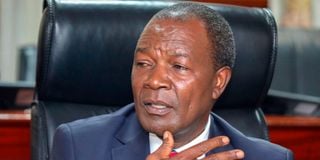Kenya’s budget indicates future ‘debt’ relations with China

National Treasury Cabinet Secretary Njuguna Ndung’u when he appeared before the Senate Standing Committee on Finance and Budget at County Hall in Nairobi on May 17, 2023.
Kenya’s budget proposals for 2023/24 may all be about money and economics. But it could also be a foreign relations tool. Who the Kenyan government approaches for relief, loans, or renegotiations, and whether it seeks further debt externally will be a part of the economic foreign relations for the next year.
But the figures so far show that Nairobi may have to contend with creditors among them China, the International Monetary Fund and even the World Bank.
With Beijing being the biggest bilateral creditor, it will even mean Kenya has to pay or at least approach China for reshaping the debt, something it has only sparingly done with other countries in a similar situation.
According to the Budget proposals due to be read in parliament this week, Kenya intends to reduce the deficit from 5.7 percent to 4.1 percent of the GDP, targeting significant, even controversial, revenue measures that have seen political noises rise in recent weeks.
President William Ruto and his government have been vocal about debt as he argued for control a lot during his campaigns last year.
“There is no country that can tax itself into prosperity. That is correct. But, you cannot accumulate debt into bankruptcy as an option,” Ruto in April in a joint media interview with TV stations.
Few expected him to borrow more than his predecessor in the first six months in office. Yet the budget proposal says Kenya intends to borrow Sh196.6 billion externally. It intends to raise Sh521.5 billion from local markets, something the Central Bank of Kenya says local markets may not raise.
In fact, the projection for local market borrowing is already higher than the past year by at least Sh80 billion. If the markets can’t raise the money, will Kenya go back to old creditors like China? It seems to be a situation of little choice.
Yet the IMF, in a recent bulletin, said Kenya must raise its liquidity to help tame the drain on forex.
“Further actions to bring back liquidity to the interbank market for foreign exchange and support exchange rate flexibility is instrumental to secure effective market functioning and backstop the external position,” the IMF staff said after the Fifth Reviews of the Extended Fund Facility and Extended Credit Facility Arrangements and the Resilience and Sustainability Facility in Kenya.
Kenya had to borrow from the World Bank, some Sh139.3 billion last months to raise its forex reserves to $7.532 billion), equivalent to 4.15 months of import cover. The forex buffer had hang lower than the required 4 months’ worth of imports, at $6.152 billion) which was just equivalent to 3.62 months of import cover.
The IMF has demanded reform of some of the state-owned firms that are also most indebted such as Kenya Power, Kenya Airways and others.
An analysis by The Business Daily showed that Ruto had already taken up Sh452 billion since he took power. Although he has cut some other spending, most of the money have gone to loan repayments, underlining the burden of the ballooning public debt. Kenya paid Sh578.4 billion to service debt in the first six to March compared to Sh501 billion in a similar period a year earlier during the Kenyatta era.
In the proposed budget, Kenya is allocating Sh1.63 trillion to pay debt, of which Sh775.1 billion will be in interest including the Sh2 billion Eurobond interest repayment which matures before the end of June. Nairobi will pay Sh850.1 billion in routine repayments for loans owed.
Kenya faces a narrow fiscal space to roll out its policies after his predecessor, Uhuru Kenyatta, increased public borrowing to fund infrastructure projects. Most of the infrastructure was built by the Chinese, who are now owed 70 percent of the bilateral debt, about $6 billion.
In the last 15 years, China lent Kenya some $9 billion to build the Standard Gauge Railway, Thika Superhighways, the Express Way, the rebuilding of the Mombasa Port, the Malindi Port and various other big-ticket projects. Most of the projects have been unable to repay themselves, as the revenues generated are low.
Ruto’s processor, Uhuru Kenyatta, had tried to force more volumes on the SGR by issuing a compulsory order for carriages of goods from the Mombasa Port. Ruto reversed the proposal, providing for importers to choose between road and railway. Whether the SGR will be viable going forward is debatable, but Kenya will have to pay for the debt, nonetheless.
The SGR and other projects cumulatively raised public debt to Sh8.66 trillion. And President Ruto admitted he had to withhold salaries to pay loans that were due.
It is a catch-22 situation: President Ruto’s economic adviser David Ndii tweeted that salaries delays were supposedly saving Kenya from defaulting.
“Is public finance that difficult? It is reported every other day debt service is consuming 60%+ of revenue. Liquidity crunches come with territory. When maturities bunch up, or revenue falls short, or markets shift, something has to give,” Ndii tweeted.
“Salaries or default? Take your pick.”
Debt position means Kenya can’t choose who among its foreign creditors who relate with or listen to. But as countries most indebted to China — including Pakistan, Zambia, Laos and Mongolia and Sri Lanka found out, Beijing isn’t that easy in relieving the debt burden especially if those loans are expensive. Sri Lanka and Zambia already defaulted. Kenya briefly got a respite last year but there is little chance of another this year. In some cases, Beijing has taken on more control of local assets to be assured of payment. Kenya says that won’t happen soon though.





